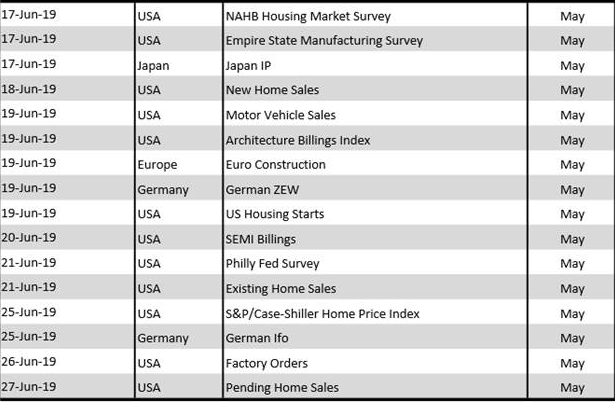Market Thoughts
Last week I wrote about my Best Fed guesses and week before that how Treasury yields are on the MOVE. But all that seems to matter is that markets are heavily betting stocks will continue to rally despite an economic slowdown (in U.S., China, pretty much everywhere) while company EPS estimates are falling.
- Per the IBES data, Q2 ’19 expected SP 500 earnings growth is just +0.3% and could slip under 0 before earnings start July 10th. H/T @TrinityAssetMan
In Jan 2001, “the Fed announced a surprise cut that sent the Nasdaq up 14% in a single day, which remains the index’s largest move since its creation in 1971. .. Folllowing that day, the Nasdaq would fall 57% before hitting bottom..” @WSJheard
While everyone is expecting rate cuts as early as next week, UBS says ‘not so fast’.
UBS: no FED cuts
- We do not think that the Fed is set to cut the federal funds rate any time soon.
- If escalation of tariffs with China is avoided, the underlying economy is slowing, but not by as much as the Fed deems necessary to sustain the expansion.
- With tariffs, the economy would slow further, but the second half of 2019 would still be above their estimate of sustainable growth.
- If we are wrong, and the economy is weaker, or escalation of the trade war causes a faster slowing in the economy, the Fed will still take a few months of data before they conclude the economy has slowed more than they desire.
- Either way, we see a cut by September as plausible but unlikely and a cut in December as possible, but only with a consistent deterioration in the real-side data.
Of course in a world of TINA and FOMO, in a world where corporate share buybacks have supported stocks, and private equity funds have reduced the outstanding shares available to a growing pool of global investment funds looking for a home, the promise of more cuts by the globes central banks – absent the Bank of England at the moment – is still seen as supportive of stocks. Greg McKenna
Economic Calendar
We actually have three central bank meetings on the agenda: the Fed, the Bank of Japan and the Bank of England. The European Central Bank gathers for a forum in Sintra, Portugal. U.S. Bank stress tests are also due but not expected to say much, since the failures aren’t released…
Earnings Calendar
#earnings scheduled for the week $CGC $ADBE $KR $ORCL $KMX $DRI $LZB $AOBC $JBL $CMC $WGO $RHT $SFUN $PSN $HX $SCS $MEI $CHKE $KFY $AMSWA $ALYA https://t.co/lObOE0dgsr pic.twitter.com/ETeWf3UDgC
— Earnings Whispers (@eWhispers) June 15, 2019
See Seeking Alpha’s Earnings Calendar for the complete list of earnings reporters.
Macro Matters
Data from Morgan Stanley showed U.S. business conditions deteriorating this month by the most on record, reaching their lowest point since 2008, adding to recent signs that the U.S. economy is slowing.
“For the Dax, the expected EPS 2019 has already been cut by 15% over the last quarters.”
And this is Before Tariffs…you know Trump is going there.#Germany https://t.co/Itg4Sx9fGi
— Samantha LaDuc (@SamanthaLaDuc) June 16, 2019
China prepares for a long trade war – shifting supply chains and getting monetary policy support from the government.
This is not a country expecting trade deal anytime soon. Why should we?
https://t.co/WQxwhz9QCr— Samantha LaDuc (@SamanthaLaDuc) June 13, 2019
Personal Note:

